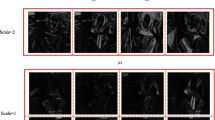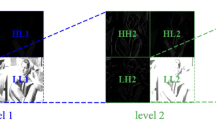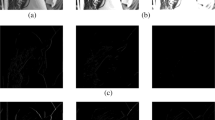Abstract
Imperceptibility, robustness and data payload, which are complimentary to each other, are widely considered as the three main properties vital for any image watermarking systems. It is a challenging work to design a statistical model-based multiplicative watermarking scheme for achieving the tradeoff among three main properties. In this paper, we propose a novel statistical image watermarking scheme by modeling local redundant discrete wavelet transform (RDWT) and fast Radial harmonic Fourier moments (FRHFMs) magnitudes with bivariate Cauchy-Rayleigh distribution. Our image watermarking scheme consists of two parts, namely, embedding and detection. In the embedding process, RDWT is firstly performed on the host image and RDWT highpass subbands are divided into non-overlapping blocks. Then FRHFMs are computed on RDWT coefficient blocks. And finally, the watermark signal is inserted into robust RDWT-FRHFMs magnitudes through a non-linear multiplicative approach. In the detection process, robust local RDWT-FRHFMs magnitudes are firstly modeled by employing bivariate Cauchy-Rayleigh distribution, which can capture accurately both marginal distributions and strong dependencies of local RDWT-FRHFMs magnitudes. Statistical model parameters are then estimated effectively by the method of logarithmic cumulants (MoLC) approach. And finally, an image watermark detector for multiplicative watermarking is developed using bivariate Cauchy-Rayleigh model and locally most powerful (LMP) test. Also, we utilize the bivariate Cauchy-Rayleigh model to derive the closed-form expressions for the watermark detector. After performance testing and comparison with the experimental results of existing methods, the proposed statistical image watermarking method has achieved relatively ideal results in terms of robustness, imperceptibility and data payload.





















Similar content being viewed by others
References
Ahmaderaghi B, Kurugollu F, Rincon JMD, Bouridane A (2018) Blind image watermark detection algorithm based on discrete Shearlet transform using statistical decision theory. IEEE Trans Comput Imaging 4(1):45–59
Akhaee MA, Sahraeian SME, Marvasti F (2010) Contourlet-based image watermarking using optimum detector in a noisy environment. IEEE Trans Image Process 19(4):967–980
Amini M, Ahmad MO, Swamy MNS (2017) A new locally optimum watermark detection using vector-based hidden Markov model in wavelet domain. Signal Process 137:213–222
Amini M, Sadreazami H, Ahmad MO, Swamy MNS (2017) Multichannel color image watermark detection utilizing vector-based hidden Markov model. Proceedings of the 2017 IEEE international symposium on circuits and systems, Baltimore, MD, USA 1–4.
Amini M, Sadreazami H, Ahmad MO, Swamy MNS (2019) A channel-dependent statistical watermark detector for color images. IEEE Trans on Multimedia 21(1):65–73
Amirmazlaghani M (2016) Additive watermark detection in the wavelet domain using 2D-GARCH model. Inf Sci 370-371:1–17
Amirmazlaghani M (2017) A novel statistical detector for contourlet domain image watermarking using 2D-GARCH model. Int Conf Image Anal Process:547–557
Amirmazlaghani M (2019) Heteroscedastic watermark detector in the contourlet domain. IET Comput Vis 13(3:249–260
Amirmazlaghani M, Rezghi M, Amindavar H (2015) A novel robust scaling image watermarking scheme based on Gaussian mixture model. Expert Syst Appl 42(4):1960–1971
Available: http://decsai.ugr.es/cvg/dbimagenes/index.php. (n.d.)
Barazandeh M, Amirmazlaghani M (2016) A new statistical detector for additive image watermarking based on dual-tree complex wavelet transform. Proceeding of the 2016 2nd International Conference of Signal Processing and Intelligent Systems. Tehran, Iran
Barazandeh M, Amirmazlaghani M (2016) A new statistical detector for additive image watermarking based on dual-tree complex wavelet transform. 2nd international conference of signal processing and intelligent systems, Tehran, Iran, 14-15. (2016: 1–5.
Bhinder P, Singh K, Jindal N (2018) Image-adaptive watermarking using maximum likelihood decoder for medical images. Multimed Tools Appl 77(8):10303–10328
Bi HB, Liu Y, Wu MM, Ge YL (2016) NSCT domain additive watermark detection using RAO hypothesis test and Cauchy distribution. Math Probl Eng 2016:1–18
Dong L, Yan Q, Lv Y, Deng SY (2016) Full band watermarking in DCT domain with Weibull model. Multimed Tools Appl 76(2):1–18
Etemad S, Amirmazlaghani M (2016) Additive watermark detector in contourlet domain using the t location-scale distribution. Proceeding of the 2016 2nd International Conference of Signal Processing and Intelligent Systems. Tehran, Iran
Etemad S, Amirmazlaghani M (2017) A new multiplicative watermark detector in the contourlet domain using t location-scale distribution. Pattern Recogn 77:99–112
Hill PR, Achim AM, Bull DR, Al-Mualla ME (2014) Dual-tree complex wavelet coefficient magnitude modelling using the bivariate Cauchy-Rayleigh distribution for image denoising. Signal Process 105:464–472
Liu J (2018) An image watermarking algorithm based on energy scheme in the wavelet transform domain. Proceedings of the 2018 IEEE 3rd international conference on image, Vision and Computing, Chongqing, China 668–672.
Liu YN, Zhang SS, Yang J (2020) Color image watermark decoder by modeling quaternion polar harmonic transform with BKF distribution. Signal Process Image Commun 88:115946
Niu PP, Shen X, Song YF, Liu YN, Wang XY (2020) Locally optimum watermark decoder in NSST domain using RSS-based Cauchy distribution. Multimed Tools Appl 79(43):33071–33101
Niu PP, Shen X, Wei TT, Yang HY (2020) Blind image watermark decoder in UDTCWT domain using Weibull mixtures-based vector HMT. IEEE Access 8:46624–46641
Rabizadeh M, Amirmazlaghani M, Attari MA (2016) A new detector for contourlet domain multiplicative image watermarking using Bessel K form distribution. J Vis Commun Image Represent 40:324–334
Sadreazami H, Ahmad MO, Swamy MNS (2015) Optimum multiplicative watermark detector in contourlet domain using the normal inverse Gaussian distribution. Proceeding of the IEEE International Symposium on Circuits & Systems. Lisbon, Portugal, pp 1050–1053
Sadreazami H, Ahmad MO, Swamy MNS (2015) A robust multiplicative watermark detector for color images in sparse domain. IEEE Trans on Circuits and Systems II: Express Briefs 62(12):1159–1163
Sedighi V, Fridrich J, Cogranne R (2015) Content-adaptive pentary steganography using the multivariate generalized Gaussian cover model. Media Watermarking, Secur, Forensics 9409H:1–13
Singh AK (2017) Improved hybrid algorithm for robust and imperceptible multiple watermarking using digital images. Multimed Tools Appl 76(6):8881–8900
Singh S, Rathore VS, Singh R, Singh MK (2017) Hybrid semi-blind image watermarking in redundant wavelet domain. Multimed Tools Appl 76(18):19113–19137
Vedovatto T, Nascimento ADCD (2017) Closed-form mathematical expressions for the exponentiated Cauchy-Rayleigh distribution. A Journal of Theoretical and Applied Statistics, Statistics
Wang CP, Wang XY, Xia ZQ (2016) Geometrically invariant image watermarking based on fast radial harmonic Fourier moments. Signal Process Image Commun 45:10–23
Wang CP, Wang XY, Xia ZQ, Zhang C (2019) Ternary radial harmonic Fourier moments based robust stereo image zero-watermarking algorithm. Inf Sci 470:109–120
Wang XY, Liu YN, Xu H, Wang AL, Yang HY (2016) Blind optimum detector for robust image watermarking in nonsubsampled Shearlet domain. Inf Sci 372:634–654
Wang XY, Wen TT, Shen X, Niu PP, Yang HY (2020) A new watermark decoder in DNST domain using singular values and Gaussian-Cauchy mixture-based vector HMT. Inf Sci 535:81–106
Wang XY, Wen TT, Wang L, Niu PP, Yang HY (2020) Contourlet domain locally optimum image watermark decoder Cauchy mixtures based vector HMT model. Signal Process Image Commun 88:115972
Wang XY, Zhang SY, Wena TT, Yang HY, Niu PP (2019) Coefficient difference based watermark detector in nonsubsampled contourlet transform domain. Inf Sci 503:274–290
Yang HY, Wang XY, Wang P, Niu PP (2015) Geometrically resilient digital watermarking scheme based on radial harmonic Fourier moments magnitude. AEU - Int J Electron Comm 69(1):389–399
Zebbiche K, Khelifi F, Loukhaoukha K (2018) Robust additive watermarking in the DTCWT domain based on perceptual masking. Multimed Tools Appl 77(16):21281–21304
Zhang P, Li BB, Boudaren MEY, Yan JK, Li M, Wu Y (2019) A novel parameter estimation method for generalized Gamma distribution towards SAR data processing. Proceeding of the 2019 6th Asia-Pacific conference on synthetic aperture radar (APSAR). Xiamen, China,: 1–6
Acknowledgments
This work was supported partially by the National Natural Science Foundation of China (Nos. 61472171 & 61701212), Key Scientific Research Project of Liaoning Provincial Education Department (LZ2019001), and Natural Science Foundation of Liaoning Province (2019-ZD-0468). Also, the author would like to thank the anonymous reviewers with their valuable comments to improve the quality of this manuscript and Yu-yang Zhang at Liaoning Normal University who helps to collect data and participate in writing of the manuscript.
Author information
Authors and Affiliations
Corresponding author
Ethics declarations
Ethical standard
All procedures performed in studies involving human participants were in accordance with the ethical standards of the institutional and/or national research committee and with the 1964 Helsinki Declaration and its later amendments or comparable ethical standards.
Informed consent
Informed consent was obtained from all individual participants included in the study.
Conflict of interest
The authors declare that they have no conflict of interest.
Additional information
Publisher’s note
Springer Nature remains neutral with regard to jurisdictional claims in published maps and institutional affiliations.
Appendix
Appendix
1.1 Appendix A. Variances and means of log-likelihood ratios under hypotheses H 0 and H 1
The performance of the LO detector can be assessed theoretically. In this section, we calculate the variances and means of the log-likelihood ratios under the H0 and H1 hypotheses, i.e., μ0, μ1, σ0, σ1. An expression for the mean μ0 of the bivariate Cauchy-Rayleigh distribution under the H0 hypothesis is derived by the following formula:
where d11 and d12 are the representations of d1 when the embedded watermark is 1 and − 1, respectively. Meanwhile, d21 and d22 are the representations of d2 when the embedded watermark is 1 and − 1, respectively.
Similarly, we also give the mean μ1 of the log-likelihood ratio based on hypothesis \( {H}_1:{y}_i={x}_i+{a}_1{a}_2^{x_i}{w}_i \) by
where \( {\alpha}_i=\frac{a_1}{2}\left({d}_{11}+\frac{d_{21}}{x_i+{a}_1{a}_2^{x_i}}\left(1-\frac{5{\left({x}_i+{a}_1{a}_2^{x_i}\right)}^2}{\gamma^2+{\left({x}_i+{a}_1{a}_2^{x_i}\right)}^2+{y}_j^2}\right)\right) \), and \( {\beta}_i=\frac{a_1}{2}\left({d}_{12}+\frac{d_{22}{a}_1}{x_i-{a}_1{a}_2^{x_i}}\left(1-\frac{5{\left({x}_i-{a}_1{a}_2^{x_i}\right)}^2}{\gamma^2+{\left({x}_i-{a}_1{a}_2^{x_i}\right)}^2+{y}_j^2}\right)\right) \).
The variance under hypothesis H0 is
The variance under hypothesis H1 is given by
Rights and permissions
About this article
Cite this article
Niu, Pp., Wang, F., Tian, J. et al. RDWT domain statistical watermark detector using FRHFMs magnitudes and bivariate Cauchy-Rayleigh distribution. Multimed Tools Appl 81, 21241–21278 (2022). https://doi.org/10.1007/s11042-022-12737-y
Received:
Revised:
Accepted:
Published:
Issue Date:
DOI: https://doi.org/10.1007/s11042-022-12737-y




